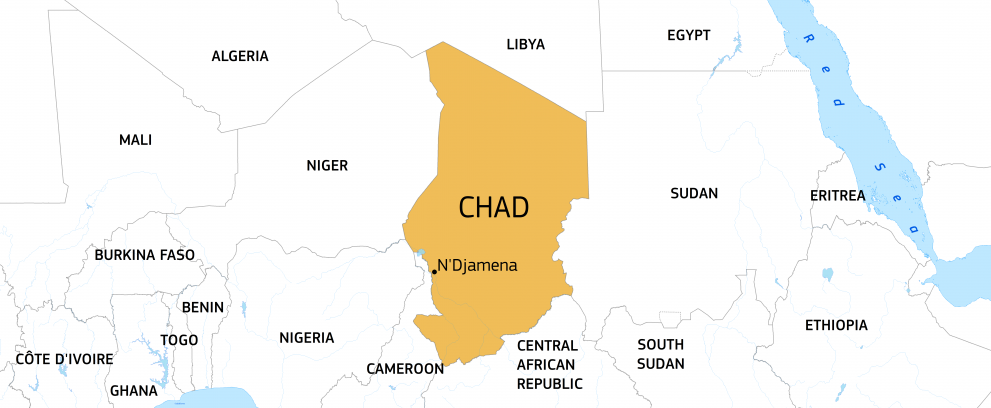Introduction
Chad is one of the poorest countries in the world, marked by low development, very limited availability of basic social services, and exposure to climate and environmental hazards.
The humanitarian situation is complex, and the needs are great. The country’s vulnerable population suffers mainly from the consequences of forced displacement, intercommunity violence, food and nutrition insecurity, floods, and droughts.
As of mid-April 2023, the crisis in the east of the country has intensified drastically following a rapid influx of forcibly displaced people from neighbouring Darfur. This comes in addition to the protracted crisis in Lake Province and the acute needs for food assistance and treatment for severe acute malnutrition in the Sahel (Barh El Gazel and Kanem).
EU humanitarian aid provides, among others, protection and multi-sectoral assistance to forcibly displaced people, life-saving treatment for undernourished children, food assistance and environmental risks.
What are the needs?
Chad faces interlinked natural and manmade humanitarian crises.
Some 7.6 million people required humanitarian assistance in 2023.
The projected figures for 2024 forecast 1.7 million children under 5 years old will suffer from acute malnutrition, almost 480,000 of whom will be classified as having severe acute malnutrition, the most serious form of undernourishment in children. According to the November 2023 Cadre Harmonisé analysis, more than 2 million people, roughly 12% of the population, require urgent humanitarian assistance. This number is expected to climb to 2.8 million people during the next lean season in 2024.
Violence and conflict in neighbouring countries have resulted in an influx of refugees and asylum seekers. Lack of resources and infrastructure means that the capacity to support displaced people is limited.
Since 2015, Chad has been the target of attacks by non-state armed groups operating in the Lake Chad Basin, leading to significant internal and cross-border population displacements.
In addition to the spillover of the Lake Chad Basin conflict into Lake Province, civilian populations are also victims of internal conflicts between communities competing for access to natural resources.
In 2023, since the start of the Sudan conflict, over 628,000 people have crossed the border to Chad, with numbers constantly growing. They arrive in an extremely precarious situation.
Before the start of this crisis, Chad was already hosting one of the largest numbers of refugees in West and Central Africa. The refugee population in the country has now exceeded 1.1 million people, of which 935,000 are Sudanese refugees. Additional sites are needed to accommodate refugees who are still at the border, including the spontaneous site in Adré.
The influx of refugees has put the existing health infrastructure under severe strain, hence the urgent need for enhanced medical and humanitarian assistance.

How are we helping?
The EU is one of the main humanitarian aid donors to Chad. In 2023, the EU allocated more than €56 million in humanitarian assistance to help the most vulnerable in the country, doubling its initial amount.
An initial amount of €45 million has been allocated for humanitarian aid to Chad in 2024.
Sudan crisis
Since the start of Sudan crisis, the EU has dedicated approximately €25 million to help respond to this emergency.
To strengthen its response, the EU has also mobilised its European Humanitarian Response Capacity (EHRC) resources.
- On 31 May, the EU launched a Humanitarian Air Bridge to Chad, delivering over 450 tons of essential supplies to partners assisting displaced people from Sudan (there have been 5 flights in total).
- The EU temporarily deployed a helicopter, in partnership with the UN Humanitarian Air Service in Eastern Chad, to access hard-to-reach areas during the rainy season.
- In collaboration with local authorities, the EU rehabilitated an airstrip in the town of Adré.
- In partnership with HI/Atlas Logistique, the EU created a logistics hub in Adré to allow the storage and shipment of humanitarian supplies.
Responding to the humanitarian needs
EU humanitarian funding allocated to respond to the refugee crisis has been used to address the most urgent needs of the refugee populations arriving in extremely precarious situations, most of whom are women and children, as well as those of the host populations, to increase their resilience and to fund activities to promote peaceful coexistence between communities and connect development, humanitarian, and peace actions.
EU humanitarian assistance has also continued to address the humanitarian needs triggered by the conflict in the Lake Chad region.
We have provided (i) food and nutrition assistance; (ii) health care; (iii) education in emergencies; (iv) water, sanitation, and hygiene services; (v) shelter and (vi) protection to communities in need.
In response to the food and nutrition crisis, the EU has funded assistance such as cash transfers, vouchers, food rations for families, ready-to-use therapeutic food, and essential medicines to treat severely malnourished children.
Anytime needed, the EU responds swiftly to new crises while supporting disaster risk reduction so that people are less vulnerable to future crises.
The EU also finances the United Nations Humanitarian Air Service (UNHAS) in Chad. These flights help aid organisations reach people in need in remote or hard-to-reach areas.
Last updated: 31/01/2024
Facts & figures
(The numbers relative to the influx of refugees and returnees are constantly evolving and subject to change).
7.6 million people need humanitarian assistance.
Over 1 million refugees, including:
- 935,000 Sudanese (new arrivals currently increasing this figure due to the crisis)
- 130,000 from CAR
- 25,000 Cameroonians
- 21,000 Nigerians
216,000 internally displaced people
78,000 Chadian returnees from CAR
131,000 Chadian returnees from Sudan
23,000 Chadian returnees from the Lake Chad province
EU humanitarian funding:
Over €56 million in 2023
€45 million initially allocated in 2024

